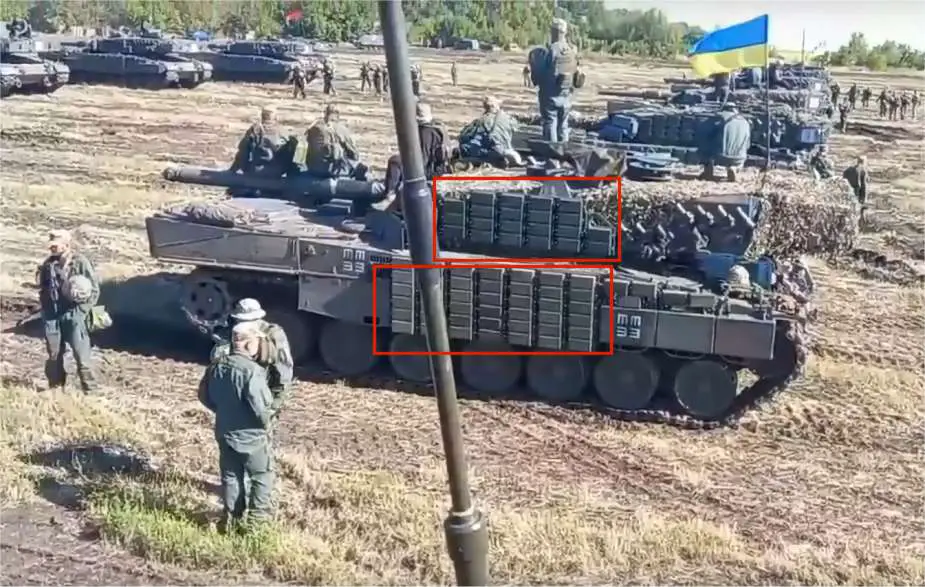- Army
- Conflicts in the world
- Israel - Iran conflict 2025
- Pakistan - India Conflict 2025
- Russia Ukraine War 2022
- Libya conflict day by day
- HAMAS - Israel War 2023
- Operation Serval in Mali French Army
- Sangaris operation Central African Republic
- Sangaris opération militaire République Centreafrique
- Ukraine - Russia conflict
- Syria conflict news
- Defence & Security Industry Technology
- Armies in the world
- Analysis Defense and Security Industry
- Conflicts in the world
- Navy
- Air
Ukraine Upgrades Leopard 2A4 Tanks with Kontakt-1 Armor To Counter Russian Threats
According to a video published on Social Network on September 2, 2023, the Ukrainian army has upgraded about 20 Leopard 2A4 Main Battle Tanks (MBTs) with Kontakt-1 a type of Explosive Reactive Armor (ERA) that was developed by the Soviet Union. In fact, the Leopard 2A4 is not protected like the Leopard 2A6. In its basic version, the Leopard 2A4 does not have armor protecting against modern ammunition and latest-generation anti-tank missiles.
Follow Army Recognition on Google News at this link

Ukrainian army Leopard 2A4 tanks fitted with Kontakt-1 ERA Explosive Reactive Armor mounted on the side of the hull and the turret. (Picture source Social Network)
Kontakt-1 is an Explosive Reactive Armor (ERA) system that originated in the Soviet Union during the 1970s. This innovative armor was among the first generations of ERA, specifically designed to bolster the protection of armored vehicles against the threats posed by shaped charge warheads, commonly found in anti-tank guided missiles and rocket-propelled grenades.
The design of Kontakt-1 is quite distinctive. It features "bricks" or "tiles" filled with explosives, which are placed between two metal plates. These are then mounted onto the external surface of the tank or other armored vehicles. The principle behind its operation is that when a shaped charge warhead strikes the ERA, the explosive within the brick is triggered to detonate. This sudden explosion disrupts the penetrative jet formed by the shaped charge, drastically diminishing its capability to breach the vehicle's primary armor.
One of the standout advantages of Kontakt-1 is the enhanced protection it offers, especially against threats that might overwhelm the base armor of the vehicle. Additionally, its modular nature means that damaged or detonated bricks can be conveniently replaced, facilitating easier field maintenance and repair. Moreover, compared to the alternative of adding more layers of passive armor, ERA systems like Kontakt-1 are more weight-efficient, preventing the vehicle from becoming excessively heavy.
However, Kontakt-1 is not without its limitations. Each brick is designed for a single use, meaning after detonation, it becomes redundant and requires replacement. There are also safety concerns associated with the explosive nature of the armor, as it could endanger infantry or nearby vehicles during a blast. Furthermore, the armor doesn't envelop the entire vehicle, which means certain areas remain exposed and potentially vulnerable.
Over the years, the Kontakt-1 ERA has been integrated into various Soviet and Russian armored vehicles, such as the T-72, T-80, and T-64 tanks. Its debut marked a significant advancement in the realm of tank protection, leading many nations worldwide to embark on the development of their own ERA variants. While more advanced generations of ERA have emerged since, offering superior protection and other benefits, the role of Kontakt-1 in the progression of armored vehicle protection during the latter part of the 20th century remains undeniable.
The armor of the Leopard 2A4 has vulnerabilities when confronted with newer threats from Russian tanks. With the Kontakt-1 ERA, the tank's protection against hits from shaped-charge ammunition, including RPG (Rocket-Propelled Grenade) grenades and older ATGMs (Anti-Tank Guided Missiles), is enhanced. This armor also offers some protection against FPV (First Person View) drones and Lancet loitering munitions. However, the tank's thin turret roof and mechanical support remain vulnerable areas.
In the backdrop of the war in Ukraine, the decision to mount the Kontakt-1 ERA on the German-made Leopard 2A4 tanks, which were donated by European countries to Ukraine, could be a strategic move. The Kontakt-1 ERA is adept at counteracting the effects of shaped charge warheads, commonly found in anti-tank guided missiles and rocket-propelled grenades.
This enhancement would provide the Leopard 2A4 with a robust defense mechanism against potential threats from Russian armored vehicles. Beyond just protection, the modularity of the Kontakt-1 design ensures that any damaged or detonated bricks can be swiftly replaced, allowing the tank to remain combat-ready even after multiple engagements. Furthermore, the weight efficiency of the Kontakt-1 ERA ensures that the Leopard 2A4 doesn't compromise on its battlefield mobility. Given the prevalent armored threats from Russia in the Ukrainian conflict, integrating the Kontakt-1 ERA on the Leopard 2A4 could significantly bolster the tank's survivability, thereby strengthening Ukraine's defensive posture.
News Russia Ukraine War


























